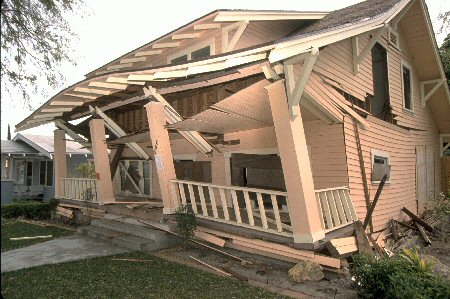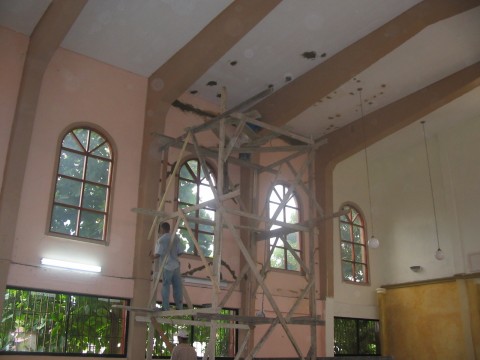
An important step in earthquake preparedness is to inspect your home and its surroundings for possible hazards and then take action to lessen those hazards. Remember: anything can move, fall, or break during an earthquake or its aftershocks.
The following is a basic checklist to help you identify and correct possible home hazards.
Check Each Room
Look for the following hazards in each room:
- Windows and other glass that might shatter
- Unanchored bookcases, cabinets, refrigerators, water heaters, and other furniture that might topple
- Heating units, fireplaces, chimneys, and stoves that could move or fall
- Areas that could be blocked by falling debris
Securing Appliances
- Secure your large appliances with flexible cable, braided wire, or metal strapping.
- Install flexible gas and water connections on all gas appliances. This will significantly reduce your chances of having a major fire after an earthquake.
- Brace and support air conditioners, particularly those on rooftops.
The typical water heater weighs about 450 pounds when full. In an earthquake, the floor on which it is standing tends to move out from under the heater, often causing it to topple. The movement can also break the gas, electric, and water-line connectors, posing fire or electric shock hazards, and can shatter the glass lining within the water heater.
Here are two suggestions on how to secure your water heater:
- Wrap at least a 1 /2-inch wide metal strap around the top of the water heater and attach it to wall studs with 3-inch lag screws. Attach another strap about 2/3 of the way down from the top of the water heater. OR...
- Wrap steel plumber's tape around the entire water heater at least twice. Then secure the tape to two different wall studs with 3-inch lag screws.
Securing Items in the Bathroom
Replace glass bottles from your medicine cabinet and around the bathtub with plastic containers.
Hanging and Overhead Items
- Inspect and anchor overhead light fixtures, such as chandeliers.
- Move heavy mirrors and pictures hanging above beds, chairs, and other places where you sit or sleep. Otherwise, anchor these items with wire through eyescrews bolted into wall studs. Or place screws on both sides, top, and bottom of the frame and screw these into the studs.
- Determine whether the full swing of your hanging lamps or plants will strike a window. If so, move them.
- Secure hanging objects by closing the opening of the hook.
- Replace heavy ceramic or glass hanging planters with light-weight plastic or wicker baskets.
Shelves, Cabinets, and Furniture

- Identify top-heavy, free-standing furniture, such as bookcases and china cabinets, that could topple in an earthquake.
- Secure your furniture by using "L" brackets, corner brackets, or aluminum molding to attach tall or top-heavy furniture to the wall eyebolts to secure items located a short distance from the wall
- Attach a wooden or metal guardrail on open shelves to keep items from sliding or falling off. Fishing line can also be used as a less-visible means of securing an item.
- Place heavy or large objects on lower shelves.
- Use Velcro-type fastenings to secure some items to their shelves.
- Secure your cabinet doors by installing sliding bolts or childproof latches.
Hazardous Materials
Identify poisons, solvents, or toxic materials in breakable containers and move these containers to a safe, well-ventilated storage area. Keep them away from your water storage and out of reach of children and pets.
Inspecting and Securing Your Home's Structure
Examine the structural safety of your house. If your house is of conventional wood construction, it will probably be relatively resistant to earthquake damage, particularly if it is a single-story structure.
For information on structural safety standards and qualified contractors in your area, contact your city or county government office on community development or building code enforcement.
The following suggestions will take an investment of time and money but will add stability to your home. If you want to do the work yourself, many hardware or home-improvement stores will assist you with information and instructions.
Foundation
Check to see if your house or garage is securely fastened to the foundation. (If your house was built before 1950, it probably does not have bolts securing the wood structure to the concrete foundation.) If your house is not secured to the foundation, take the following steps:
- Using a hammer drill and carbide bit, drill a hole through the sill plate into the foundation. Holes should be approximately 6 feet apart.
- Drop a 1/2- x 7-inch expansion bolt into each hole and finish by tightening the nut and washer.
Beams, Posts, Joists, and Plates

Strengthen the areas of connection between beams, posts, joists, and plates using the following hardware:
- "T" and "L" straps
- Mending plates
- Joist hangers
- Twin post caps
- Nails and lag screws
Pay particular attention to exposed framing in garages, basements, porches, and patio covers.
Roof and Chimney
- Check your chimney or roof for loose tiles and bricks that could fall in an earthquake. Repair loose tiles or bricks, as needed.
- Protect yourself from falling chimney bricks that might penetrate the roof, by reinforcing the ceiling immediately surrounding the chimney with 3/4-inch plywood nailed to ceiling joists.
Learning to Shut Off Utilities
- Know where and how to shut off utilities at the main switches or valves. Check with your local utility companies for instructions.
- Teach all family members how and when to shut off utilities.
Gas
- An automatic valve (Earthquake Command System) is commercially available that will turn the gas off for you in the event of an earthquake.
- After an earthquake, DO NOT USE matches, lighters, or appliances, and do not operate light switches until you are sure there are no gas leaks. Sparks from electrical switches could ignite gas, causing an explosion.
- If you smell the odor of gas, or if you notice a large consumption of gas being registered on the gas meter, shut off the gas immediately. First, find the main shut-off valve, located on a pipe next to the gas meter. Use an adjustable wrench to turn the valve to the off position.
Electricity
After a major disaster, shut off the electricity. Sparks from electrical switches could pose a shock or fire hazard. Carefully turn off the electricity at the main electrical breaker in your home.
Water
Water may be turned off at either of two locations:
- At the main meter, which controls the water flow to the entire property; or
- At the water main leading into the home. (Shutting off the water here retains the water supply in your water heater, which may be useful in an emergency.)
Attach a valve wrench to the water line. (This tool can be purchased at most hardware stores.) Also, label the water mains for quick identification.
 Print
Print Email
Email







